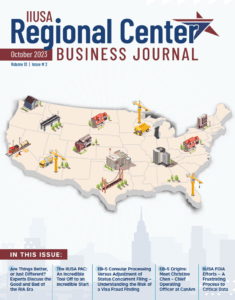![]() IIUSA is proud to announce that next week, it will release the much anticipated report Economic Impacts of the EB-5 Immigration Program 2012. The IIUSA-commissioned report, prepared by David Kay of IMPLAN Group, LLC and peer-reviewed by Professors Eric Thompson and Hart Hodges of Association for University Business Economic Research (AUBER) estimates that spending associated with EB-5 investors contributed $3.39 billion to U.S. GDP and supported over 42,000 U.S. jobs during 2012. This is more than a 2-fold increase from the average annual impact result reported in 2011, and includes impacts associated with investment spending, household spending, and other immigration expenses. Furthermore, during 2012, spending by EB-5 investors also contributed over $447 million to federal tax revenues and $265 million to state and local tax revenues.
IIUSA is proud to announce that next week, it will release the much anticipated report Economic Impacts of the EB-5 Immigration Program 2012. The IIUSA-commissioned report, prepared by David Kay of IMPLAN Group, LLC and peer-reviewed by Professors Eric Thompson and Hart Hodges of Association for University Business Economic Research (AUBER) estimates that spending associated with EB-5 investors contributed $3.39 billion to U.S. GDP and supported over 42,000 U.S. jobs during 2012. This is more than a 2-fold increase from the average annual impact result reported in 2011, and includes impacts associated with investment spending, household spending, and other immigration expenses. Furthermore, during 2012, spending by EB-5 investors also contributed over $447 million to federal tax revenues and $265 million to state and local tax revenues.
The History of Economic Impact Reports for the EB-5 Regional Center Program
In 2010 published USCIS-commissioned report attempted to estimate the economic impacts of the EB-5 program at a national level. The report used a sample of approved I-829 forms (from 2001-2006) weighted by the number of approved EB-5 visas to estimate direct investment for all EB-5 investors. The analysts then used IMPLAN to estimate the indirect and induced impacts of these investments. However, the 2010 analysis was based on a sample that may not have been representative of the average EB-5 investor. In addition, the sample covered the period 2001-2006 and the EB-5 program has grown immensely since that time. Furthermore, the USCIS report was also limited to measuring the impact of investment expenditures only. It did not attempt to estimate the impact associated with household spending or other immigration expenses. Finally, the 2010 analysis was also limited to measuring economic impacts at a national level. It did not attempt to estimate the program’s impact at a state level.
IIUSA has now commissioned two economic impact reports based on comprehensive datasets of I-526 and I-829 approval/denial statistics for each Regional Center in the country for fiscal years 2010-2012. We obtain this data through a vigorous process that starts with a series of Freedom of Information Act (FOIA) requests and subsequent analysis of I-924A filings. The breakdown of the “new commercial enterprises” and “job creating enterprises” that Regional Centers funded throughout the year, along with North American Industry Classification System (NAICS) codes to track industry sector impacts Once all of this data is broken down, formatted, and analyzed multiple times over – it is sent for economic analysis, peer-review, and (finally) publishing.
The December 2013 Department of Homeland Security (DHS), Office of the Inspector General (OIG) report on the EB-5 Regional Center Program stated that USCIS has been unable to quantify the economic impact of the Program. USCIS’ response to the OIG report stated that its mission was to administer the adjudication of immigration benefits, not measure economic impact. IIUSA has been able to do so ever since USCIS implemented the I-924A in 2011 because it provides a comprehensive dataset needed for a detailed report in terms of geography and industry impacts.
Last year, IIUSA commissioned IMPLAN Group, LLC, makers of the IMPLAN system of software and data, to produce an annual reporting update to more fully estimate the ongoing impacts associated with the EB-5 Regional Center program. This report estimated economic impacts over the 2010-2011 period to be: $2.6+ billion in GDP, 33,000+ in U.S. jobs supported, and $346+ million in federal/state/local tax revenue. In September, IIUSA compared the IIUSA-commissioned report with the USCIS Study from 2010 in a blog post.
Summary of 2012 Economic Impact Report
The 2012 Economic Impact Report is an extension of the same methodology used to perform the 2010-2011 report but estimates impacts for 2012. The report includes a detailed analysis of household spending including flight, automobile, investment and legal and federal immigration expenditures. Also, the report documents the top ten impacted sectors by employment by jobs supported and overall contribution to gross domestic product (GDP).
Utilizing the data of 2012 economic impacts, the report is able to make projections to “scale up” the results to show what impacts may look like if the current visa limit is reached (10,000) or increased (20,000). If the current regulatory environment and spending pattern remain unchanged, spending associated with EB-5 investor households would support over 72,000 U.S. jobs and contribute $5.7 billion to U.S. GDP when the 10,000 visa limit is reached. The program would also support over $754 million in federal tax revenues and $459 million in state & local tax revenues. At the 20,000 visa limit, EB-5 investor spending would support over 144,000 U.S. jobs and contribute $11.4 billion to GDP. Federal tax revenue would increase to $1.5 billion and state & local tax revenue would increase to $918 million.
How to Purchase?
The Economic Impacts of the EB-5 Immigration Program 2012 report will be available next week through the IIUSA Marketplace.
The report will also be made available automatically to All-Access Pass holders. In addition to receiving the 2012 Report, All-Access Pass holders will be registered for all 12 IIUSA webinars (hosted monthly), receive exclusive multimedia content, and past industry reports for one flat fee. Purchase today! With questions, please contact Allen Wolff, allen.wolff@iiusa.org or 312-283-8167.








